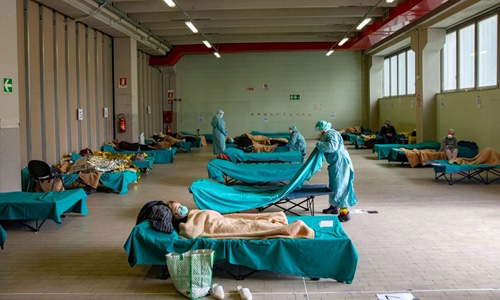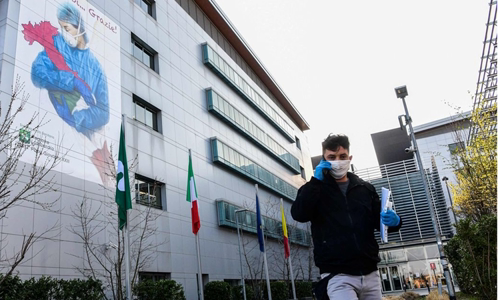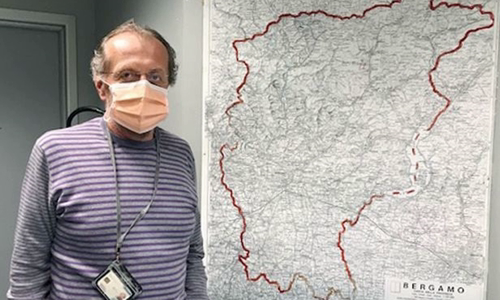Ambulance in Bergamo no longer howls, because it only makes people more afraid, when hospitals have "collapsed" before the pandemic.
Most of these ambulances were flocking to Papa Giovanni XXIII Hospital, a large and modern medical facility in the city of Bergamo, Bergamo province, Lombardy, which was heavily influenced by Covid-19. The hospital does not have enough ventilators for all patients with nCoV with respiratory failure. The intensive care unit almost never accepts nCoV-infected patients over 70 years of age, when their chances of survival are very low.

Temporary treatment area for Covid-19 patients at a Brescia city hospital Photo: Bloomberg News.
The rooms that had been left at the hospital were now filled with critically ill patients and filled with cries of oxygen. The patients with exhausted faces lay quietly, full of anxiety in the sickroom. Everyone is trying to grab every breath. There are patients who use oxygen caps, which look like transparent buckets sealed on their necks.
"Some of them need to be transferred to an intensive care unit and intubated," said Pietro Brambillasca, anesthesiologist, adding that the remaining patients should be better quarantined so that they cannot be infect anyone.
But that is now impossible. The hospital is already overcrowded, so it is impossible for all patients to receive the best care.
Covid-19 was devastating the city of Bergamo and pushing a rich land with a high-tech healthcare system to the brink of a humanitarian disaster. This has raised alarm bells with the United States and many other developed countries in the fight against nCoV.
A number of American doctors are trying to figure out how nCoV can defeat all its attempts to control the epidemic in Lombardy, which has two major cities, Bergamo and Milan. They want to learn from the lesson but do not have much time, because the pandemic, which is under control in China, has spread to the West.
Maurizio Cereda, emergency resuscitation and anesthesiologist in Philadelphia, recently shared a list of lessons from Italy for colleagues. Cereda, currently at the University of Pennsylvania Hospital, has been trained in Milan and has close relationships with doctors in Bergamo and many other places.
Many of these lessons are about public health and avoiding hospital overcrowding. "Mild to moderate infections should be treated at home instead of in the hospital and should be deployed widely for remote examination services," he wrote. Some treatments can be done at home through mobile clinics.
Another lesson involves Italian ambulance service workers who are at high risk of infection and can spread the disease to others when they have to travel everywhere, according to Cereda.
He also warned that smaller hospitals are not prepared to deal with a large number of patients, making them very vulnerable. He suggested transferring the most severe patients to major medical facilities, and using private ambulances for suspected people to limit the risk of cross-contamination to others.
Italy has recorded 2,503 deaths from nCoV and will most likely exceed mainland China's 3,237 deaths in the next few days, as the European country reports more than 300 deaths a day in recent days. here. Italy's aging population is also vulnerable to Covid-19 attacks.
About two-thirds of all deaths in Italy are in Lombardy, which is considered the epicenter of Europe. Here, Covid-19 is becoming more and more dangerous when hospitals in the most affected areas have reached the limit. Bergamo is considered to be the best evidence that Covid-19 was out of control in Italy and "knocked out" hospitals.
Research into the worrisome situation in Italy could help prepare US doctors better, said Brendan Carr, chief of the emergency department at a hospital of the Mount Sinai Health System in New York City.
Dr. Carr said that he and many other doctors in the US have been in contact with their Italian colleagues in recent weeks. "The things they say are scary, but help us gain a lot of experience," he said.
One of the lessons is to prepare to be able to cope with the influx of nCoV infected people rushing to the hospital. Dr. Carr said Mount Sinai Hospital is preparing a new intensive care bed.

A man wearing a mask at Papa Giovanni XXIII Hospital, in the city of Bergamo Photo: AFP.
Bergamo is an example of what can happen in the wrong direction. Normally, the ambulance service of Papa Giovanni Hospital worked very well. Patients who call the 112 hotline will be answered within 15-20 seconds. The hospital's ambulance fleet of over 200 is always ready to depart in 60-90 seconds. Two ambulance helicopters can operate 24/7. Usually about 30 minutes later, patients are transferred to the emergency room.
"Normally, we are always very fast and efficient," said Angelo Giupponi, who runs the hospital's ambulance service.
But now the family members of stroke patients have to wait for hours when calling for an ambulance because the hotlines are busy, Dr. Giupponi said. Each day his team received 2,500 calls and transported 1,500 people to the hospital.
"We could not count the number of times the emergency medical staff went home for the first time but left because the patients did not need to be hospitalized, then were called back when their situation worsened," he said.
Ambulance workers were not trained to deal with an infectious disease like Covid-19, which infected many people and later spread it to the whole team. Diego Bianco, an emergency coordinator in his 40s and no medical history, died on March 14 after being infected with nCoV.
"He has never been in contact with the patient. He has only answered the phone. It proves that the virus can appear everywhere," Bianco's colleague said at the emergency dispatch center on March 15. Despite wearing a mask, the faces of the employees here still showed anxiety.
Papa Giovanni XXIII Hospital, opened in 2012 with 950 beds, is one of the most modern medical facilities in Italy. This hospital treats everything from trauma, heart surgery to organ transplants.
More than 400 beds here are now dedicated to serving people infected or suspected nCoV. The emergency resuscitation department currently has about 100 patients, mostly related to Covid-19. New cases continue to drag. Three of the hospital's top 4 managers were infected.
"Just three weeks ago, we were able to do everything for all patients. But now we have to choose the person who goes to the emergency recovery room. It's a disaster," the doctor said. mesmerizing Mirco Nacoti said.
Nacoti has worked for Doctors Without Borders in Haiti, Chad, Kurdistan and Ivory Coast. He is one of the few doctors in Bergamo who has experience with epidemics. However, these are all diseases that have been treated with vaccines, such as measles and rubella.
He estimates that more than 60% of Bergamo residents are infected with nCoV. "Many people with nCoV have no symptoms and many die at home without testing. The number of people in the emergency resuscitation department is just the tip of the iceberg," said Dr Nacoti.
Hospitals in the United States as well as across Europe must be prepared in advance and governments need to blockade the community before it is too late, according to Nacoti.
"The disease does not allow you time to learn from mistakes. Every day you lose is a day of more severe translation," Nacoti said.
Bergamo, a city of about 120,000 people in northeast Milan, is located in the heart of the Lombardy region, one of the richest regions in Italy. San Pellegrino mineral water companies, luxury yachts or brake pads for Ferrari cars are located around the city. There is also a medieval citadel that attracts tourists.

Angelo Giupponi, head of the ambulance service of Papa Giovanni XXIII Hospital, Bergamo City Photo: WSJ.
When Bergamo discovered a Covid-19 outbreak in the remote towns of the city on February 22, Dr. Giupponi of Papa Giovanni Hospital immediately sent an email to Lomberdy health officials. He called for evacuation of a number of hospitals for use as a reception site for nCoV-infected patients.
But regional officials were also dealing with an outbreak in southern Milan. "We have had three days of sleeplessness and now do not want to read any more of his bullshit," an email from Giupponi received from the Lomberdy regional government.
However, a blockade order was later turned Bergamo into a ghost town.
The obituary section in the local newspaper Bergamo Echo used to occupy just over a page, but now it has nine newspapers. During the break, doctors of Papa Giovani Hospital shared heartbreaking stories. A nursing home called them to notify someone over 80 years old with nCoV, but the hospital refused to accept it.
"None of us have ever seen something like that. We were trained to deal with emergencies, like earthquakes, but not epidemics," orthopedic surgeon Michele Pisano. to speak.
In these days, Pisano has little to do, because a nationwide blockade means there will be no car crashes or ski fractures. However, he can assist his colleagues in the isolation rooms.
In small towns in Bergamo province, local hospitals are under even greater pressure. Dr. Nacoti is supporting a hospital in San Giovanni Bianco, located at the foot of the Apls. On the evening of 15/3, the hospital received about 70 patients, but only 20 beds, because this facility specializes in outpatient treatment.
Newly arrived patients must lie on an ambulance stretcher in the emergency room or hallway while waiting for an empty bed. On the upper floors, more than 50 patients have to use ventilators. Some were in critical condition but the hospital now had no room in the emergency recovery room or ventilator.
"We used to think that just seven bunk beds and seven bunk beds would be enough," said nurse Fiorella Busi.
The hospital was planning to transfer a serious case to Bergamo. "But we know the information that if patients over 65 or 70 years will not be intubated. So we decided to leave them and do everything we can," said Dr. Davide Grataroli. know.
This situation has been going on for nearly three weeks. Patients know that many people will find it difficult to survive with limited care in today's overcrowded hospitals. "They accept and don't complain about this," Busi said.
"The most heartbreaking thing is that they have to die alone. Families often only see them last time in the emergency room and next time in the morgue," she said.
Busi added that dying in solitude is difficult to accept because "it's not our culture. Here we always live together".



 TiffanyAlipater
TiffanyAlipater







